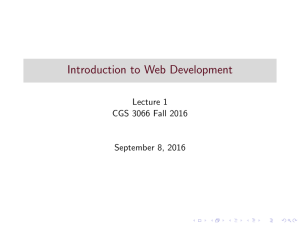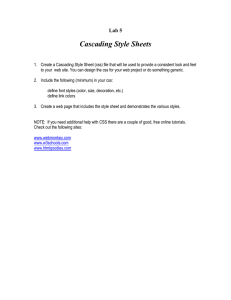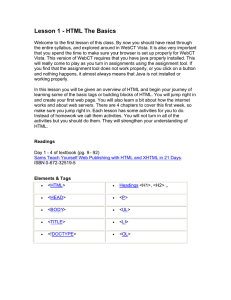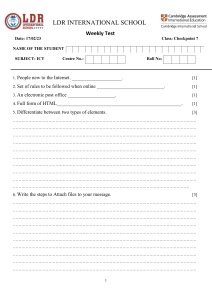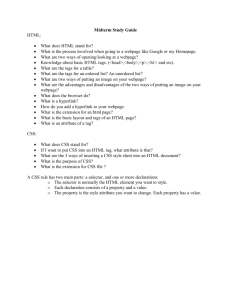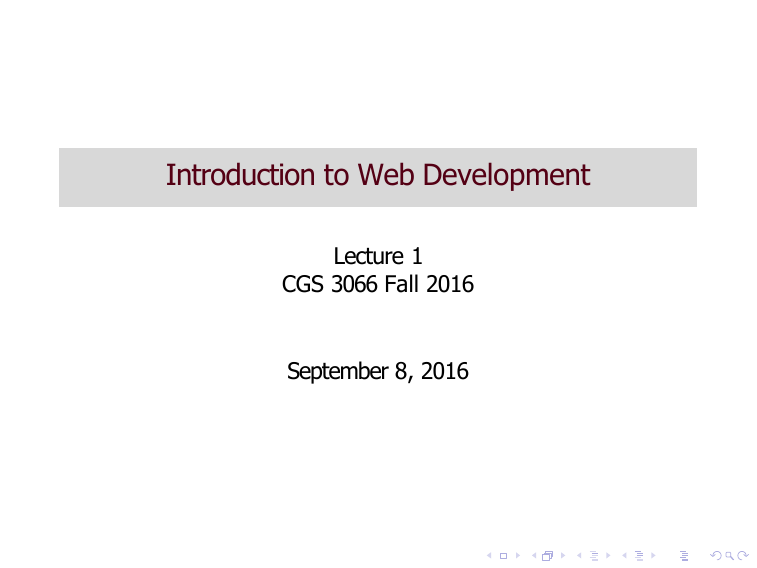
Introduction to Web Development Lecture 1 CGS 3066 Fall 2016 September 8, 2016 Why learn Web Development? Why learn Web Development? ► ► ► ► ► ► ► Reach Today, we have around 12.5 billion web enabled devices. Visual Medium It’s easier to market your product if people can “see” it. The Social Nature of the web. It’s fun. ;) It pays very well. $$ You can market your own idea (as opposed to having a “technical co-founder” for your start-up). It’s important to do it well. How it works What we’ll learn in this course ► HTML 5 - The current standard for the language that describes the contents of the webpage. ► CSS - Used to add styles to a plain HTML document. JavaScript - Makes the website dynamic. Responds to user. PHP - Scripting language used on the server side. Used to connect the website to other utilities. We’ll be looking at several JavaScript frameworks including jQuery, Angularjs and React.js. ► ► ► ► As we progress through the course, elements of basic software engineering, content management, responsive design and Material Design will be introduced. HTML ► HTML is a markup language. It tells the web browser what content to display. ► Separates content from presentation. Uses a pre-defined set of elements to identify content types. Elements contain one or more “tags”. Tags are surrounded by angle brackets, and the “closing” tag is prefixed by a forward slash. ► ► ► HTML Page Structre HTML Tree Structure DOCTYPE ► The DOCTYPE is typically the first line of the HTML document. ► It specifies the version of HTML used on the page. HTML5 has a very simple DOCTYPE element. <!DOCTYPE html> HTML4 DOCTYPE element <!DOCTYPE html PUBLIC “-//W3C//DTD HTML 4.01 Transitional//EN”> ► ► Basics of HTML 5 ► ► Every HTML document (web page) consists of tags and character data. Tags are elements enclosed in angle brackets. ► ► ► <html>, <body>, <a>, </a >, </body>, </html> Opening and ending tags must be used together. Character data is the content between an opening and closing tag. <title >Hello World </title > HTML Elements ► An element is a combination of a tag and its character data. ► ► ► ► ► ► ► ► <title>Hello World </title> <body><p>Welcome to the world </p></body> <a href=“www.google.com”>Google </a> <br/> It is possible to nest elements inside other elements. It is possible to have empty element (no content/character data). HTML tags are not case sensitive. By convention, tags are written in lowercase. Attributes ► ► Attributes provide information about HTML elements. An element can have one or more attributes. ► ► ► ► ► ► id class style href Attributes come in name/value pairs. <a href=“www.google.com” >Go to Googles website </a> Some attributes can be used on any HTML element: ► ► ► ► class: specifies one or more classnames for an element (refers to a class in a style sheet). id: specifies a unique id for an element. style: specifies an inline CSS style for an element. title: specifies extra information about an element. HTML Comments ► Comments can be added into the HTML code to make it readable and understandable. ► Browsers will not display any comments. Syntax: <!– –> E.g., <!– This is my comment –> ► Cascading Style Sheets ► ► ► ► ► ► CSS stands for Cascading Style Sheets. Current Version: CSS 3. Styles define how to display HTML elements. Styles were added to HTML 4.0 to solve a problem. The original purpose of HTML was to combine the structure and content of the page into one document. When presentation elements began to be included in the document, it increased the complexity and reduced readability. The Solution Why CSS? ► ► Separate the “style” elements from the documents and put it in a “style sheet”. Advantages: ► ► ► Styles can be changed easily. Document is more readable. 3 ways to do styling ► ► Inline Style - Style elements are included as HTML attributes. Internal Style Sheets - A <style>tag is used in the HTML document to specify the presentation elements. External Style Sheets - A separate “.css” file is used as a part of your set of documents. It contains all the styling elements.
